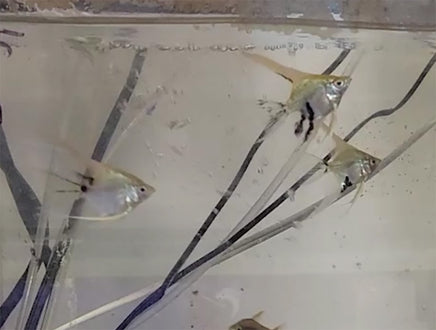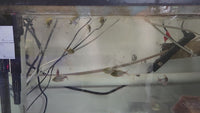Pterophyllum is a small genus of freshwater fish from the family Cichlidae known to most aquarists as angelfish. All Pterophyllum species originate from the Amazon Basin, Orinoco Basin and various rivers in the Guiana Shield in tropical South America. The three species of Pterophyllum are unusually shaped for cichlids being greatly laterally compressed, with round bodies and elongated triangular dorsal and anal fins. This body shape allows them to hide among roots and plants, often on a vertical surface. Naturally occurring angelfish are frequently striped transversely, colouration which provides additional camouflage. Angelfish are ambush predators and prey on small fish and macroinvertebrates. All Pterophyllum species form monogamous pairs. Eggs are generally laid on a submerged log or a flattened leaf. As is the case for other cichlids, brood care is highly developed.
Species
The most commonly kept species in the aquarium is Pterophyllum scalare. Most of the individuals in the aquarium trade are captive-bred. Sometimes, captive-bred Pterophyllum altum is available. Pterophyllum leopoldi is the hardest to find in the trade.
Care
Angelfish are kept in a warm aquarium, ideally around 80 °F (27 °C). Though angelfish are members of the cichlid family, they are generally peaceful when not mating; however, the general rule "big fish eat little fish" applies.
Breeding
P. scalare is relatively easy to breed in the aquarium, although one of the results of generations of inbreeding is that many breeds have almost completely lost their rearing instincts, resulting in the tendency of the parents to eat their young.[citation needed] In addition, it is very difficult to accurately identify the sex of any individual until it is nearly ready to breed.
Angelfish pairs form long-term relationships where each individual will protect the other from threats and potential suitors. Upon the death or removal of one of the mated pair, breeders have experienced the total refusal of the remaining mate to pair up with any other angelfish and successfully breed with subsequent mates.
Depending upon aquarium conditions, P. scalare reaches sexual maturity at the age of six to 12 months or more. In situations where the eggs are removed from the aquarium immediately after spawning, the pair is capable of spawning every seven to 10 days. Around the age of three years, spawning frequency decreases and eventually ceases.
When the pair is ready to spawn, they choose an appropriate medium upon which to lay the eggs, and spend one or two days picking off detritus and algae from the surface. This medium may be a broad-leaf plant in the aquarium, a flat surface such as a piece of slate placed vertically in the aquarium, a length of pipe, or even the glass sides of the aquarium. The female deposits a line of eggs on the spawning substrate, followed by the male, which fertilizes the eggs. This process is repeated until a total of 100 to more than 1,200 eggs are laid, depending on the size and health of the female fish. As both parents care for the offspring throughout development, the pair takes turns maintaining a high rate of water circulation around the eggs by swimming very close to the eggs and fanning them with their pectoral fins. In a few days, the eggs hatch and the fry remain attached to the spawning substrate. During this period, the fry survive by consuming the remnants of their yolk sacs. At one week, the fry detach and become free-swimming. Successful parents keep close watch on the eggs until then. At the free-swimming stage, the fry can be fed suitably sized live food.
P. altum is notably difficult to breed in an aquarium environment.
Compatibility with other fish
In pet stores, the freshwater angelfish is typically placed in the semiaggressive category. Some tetras and barbs are compatible with angelfish, but ones small enough to fit in the mouth of the angelfish may be eaten. Generous portions of food should be available so the angelfish do not get hungry and turn on their tank mates.



